
The blue-tailed day gecko is a diurnal species of gecko, a lizard in the family Gekkonidae. The species is endemic to the island Mauritius. It typically inhabits warm and humid places and dwells on different trees and bushes.
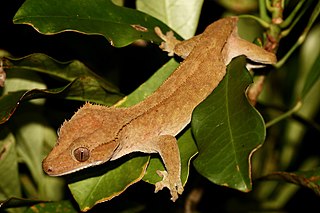
The crested gecko or eyelash gecko is a species of gecko native to southern New Caledonia (France). In 1866, the crested gecko was described by French zoologist Alphonse Guichenot. This species was thought to be extinct until it was rediscovered in 1994 during an expedition led by Robert Seipp. Along with several other New Caledonian gecko species, it is being considered for protected status by the Convention on the International Trade in Endangered Species of Wild Flora and Fauna.

The leopard gecko or common leopard gecko is a ground-dwelling lizard native to the rocky dry grassland and desert regions of Afghanistan, Iran, Pakistan, India, and Nepal. The leopard gecko has become a popular pet, and due to extensive captive breeding it is sometimes referred to as the first domesticated species of lizard.

The tokay gecko is a nocturnal arboreal gecko in the genus Gekko, the true geckos. It is native to Asia and some Pacific Islands.
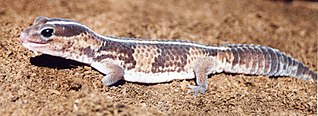
The African fat-tailed gecko or fat-tail gecko is a ground-dwelling species of gecko from West Africa and Cameroon.

Lachesis muta, also known as the Southern American bushmaster or Atlantic bushmaster, is a venomous pit viper species found in South America, as well as the island of Trinidad in the Caribbean. Two subspecies are currently recognized, including the nominate subspecies described here.

Huevos is an island in the Republic of Trinidad and Tobago. The island is 1.01 km2 in area. It is one of the "Bocas Islands", which lie in the Bocas del Dragón between Trinidad and Venezuela.

The black-headed night monkey is a night monkey species from South America. It is found in Brazil, Bolivia and Peru. The A. nigriceps in Peru were notably inhabiting areas that were degraded, and often these areas were disturbed either by human activities or natural occurrences in the ecosystem. A black-headed night monkey is about the same size as a small squirrel. Black-headed night monkeys have small ears that are hidden by their fur. When they become adults they are about 750g and usually are about 14 months old. Black-headed night monkeys have three black stripes that meet on their forehead. These monkeys have white patches by their eyes, cheeks, and under their mouth. Their eyes are very large and brown.

The bare-tailed woolly opossum is an opossum from South America. It was first described by Swedish zoologist Carl Linnaeus in 1758. The bare-tailed woolly opossum is characterized by a gray head, brown to gray coat, orange to gray underside and a partially naked tail. It is nocturnal and solitary; there is hardly any social interaction except between mother and juveniles and in mating pairs. The opossum constructs nests in tree cavities, and its litter size ranges from one to seven. Gestation lasts 25 days, and the juveniles exit the pouch after three months; weaning occurs a month later. The bare-tailed woolly opossum inhabits subtropical forests, rainforests, secondary forests, and plantations; its range extends from northern Venezuela to northeastern and southcentral Brazil. The IUCN classifies this opossum as least concern.

The tropical house gecko, Afro-American house gecko or cosmopolitan house gecko is a species of house gecko native to sub-Saharan Africa. It is also currently found in North, Central and South America and the Caribbean, where it has been inadvertently introduced by humans.
Kwaza is an endangered Amazonian language spoken by the Kwaza people of Brazil. Kwaza is an unclassified language. It has grammatical similarities with neighboring Aikanã and Kanoê, but it's not yet clear if that is due to a genealogical relationship or to contact.
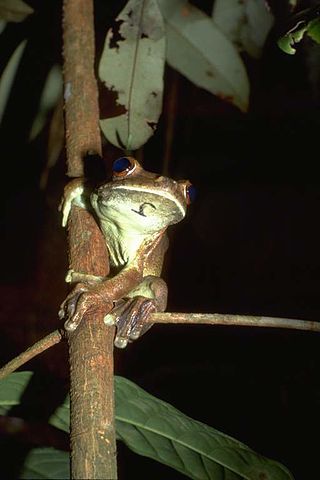
The rusty tree frog, also known as the giant gladiator treefrog, is a species of frog in the family Hylidae found in South America and Panama. Its natural habitats are subtropical or tropical moist lowland forests, rivers, and intermittent freshwater marshes. In some areas, it is sympatric with H. rosenbergi.
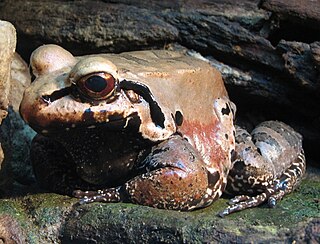
The smoky jungle frog is a species of frog in the family Leptodactylidae. It is found in Bolivia, Brazil, Colombia, Ecuador, Costa Rica, Panama, French Guiana, and Peru. Its natural habitats are tropical and subtropical moist broadleaf forests, subtropical or tropical swamps, subtropical or tropical moist montane forest, rivers, freshwater marshes, intermittent freshwater marshes, and aquaculture ponds.
Aikanã is an endangered language isolate spoken by about 200 Aikanã people in Rondônia, Brazil. It is morphologically complex and has SOV word order. Aikanã uses the Latin script. The people live with speakers of Koaia (Kwaza).

Dinoponera gigantea is a species of ant belonging to the family Formicidae.
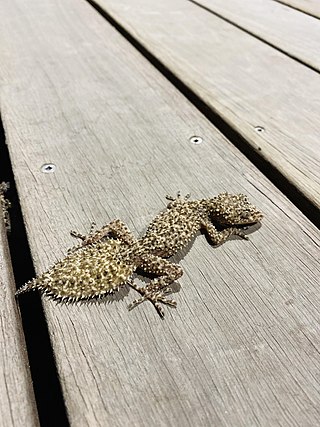
The broad-tailed gecko, southern leaf-tailed gecko, or Sydney leaf-tailed gecko is a common gecko of the family Carphodactylidae found in the Sydney Basin. The species uses its mottled colour to camouflage against bark or rock, and if threatened can drop its large fleshy tail as a decoy. The tail is also useful for fat storage. This species of gecko is available in captivity as a pet, they are a nocturnal ambush hunter, relying on camouflage and patience to catch prey. Primary prey items include large nocturnal invertebrates such as spiders, cockroaches and beetles.

Anolis fuscoauratus, commonly known as the slender anole, slender Amazon anole, or brown-eared anole, is a species of lizard in the family Dactyloidae. The species is native to northern South America and Panama.

Thecadactylus solimoensis is a species of gecko described in 2007. It is often confused with T. rapicauda, the turnip-tailed gecko. This species is found at elevations of 120–200 m (390–660 ft) above sea level in Ecuador, Peru, Bolivia, southern Colombia and western Brazil, mostly within the headwaters of the Amazon river system.

Clelia clelia, commonly known as the black mussurana or windward cribo, is a species of snake in the family Colubridae. The species is native to the New World.

The Brazilian gecko is a species of gecko, a lizard in the family Phyllodactylidae. The species is endemic to South America. The Brazilian Gecko feeds mostly on arthropods specifically Diptera.



















